Book contents
- Early Modern Herbals and the Book Trade
- Early Modern Herbals and the Book Trade
- Copyright page
- Dedication
- Contents
- Figures
- Acknowledgments
- Note on Transcription and Citation
- Abbreviations
- Prologue
- Introduction
- Part I A History of Herbals
- Part II Anonymity in the Printed English Herbal
- Part III Authors and the Printed English Herbal
- Bibliography
- Index
- References
Bibliography
Published online by Cambridge University Press: 23 December 2021
- Early Modern Herbals and the Book Trade
- Early Modern Herbals and the Book Trade
- Copyright page
- Dedication
- Contents
- Figures
- Acknowledgments
- Note on Transcription and Citation
- Abbreviations
- Prologue
- Introduction
- Part I A History of Herbals
- Part II Anonymity in the Printed English Herbal
- Part III Authors and the Printed English Herbal
- Bibliography
- Index
- References
Summary
- Type
- Chapter
- Information
- Early Modern Herbals and the Book TradeEnglish Stationers and the Commodification of Botany, pp. 263 - 282Publisher: Cambridge University PressPrint publication year: 2022
- Creative Commons
- This content is Open Access and distributed under the terms of the Creative Commons Attribution licence CC-BY-NC 4.0 https://creativecommons.org/cclicenses/



